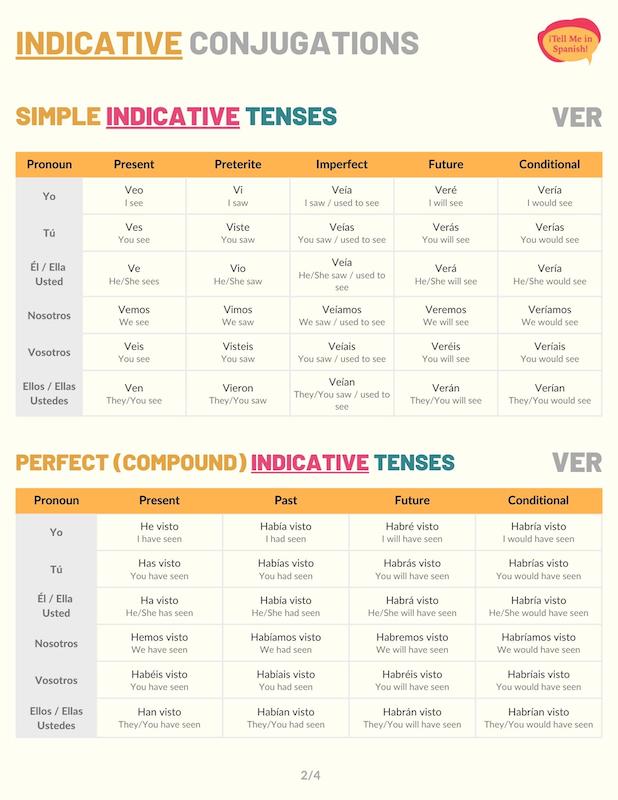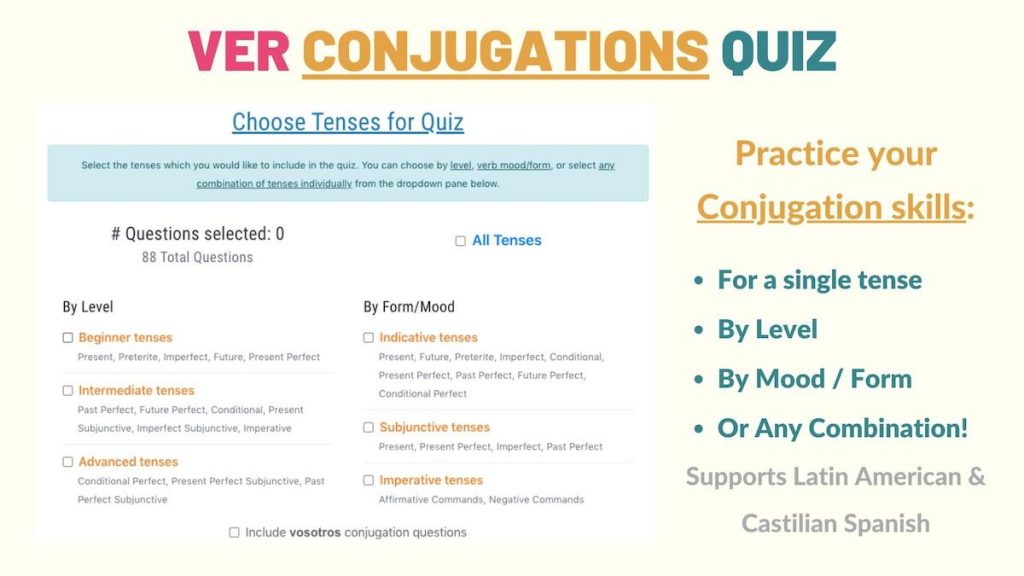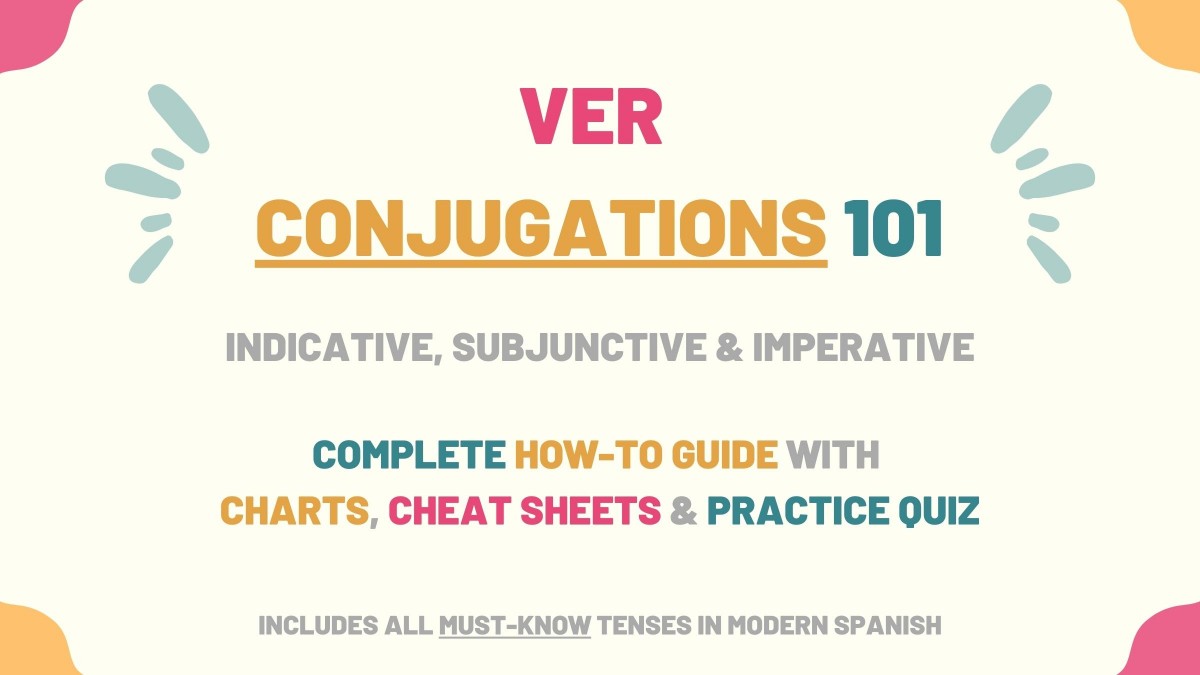Ver is a basic -ER verb you need to incorporate into your Spanish vocabulary. Since this verb has many irregularities in most tenses, in this guide, we’ll go over the most important ver conjugation charts. Here’s is a quick overview of what you’ll learn:
- Ver Overview
- Indicative Tenses of Ver Conjugations
- Subjunctive Tenses of Ver Conjugations
- Imperative (Commands) of Ver Conjugations
- Uses & Examples
- Download Ver Conjugation Tables & Uses Cheat sheets
- Ver Conjugation Practice Quiz
Overview of Ver
| Verb Characteristic | Property |
|---|---|
| Verb Type | -ER |
| Irregular | Yes |
| Infinitive | Ver |
| Gerund (Present Participle) Form | Viendo |
| Past Participle Form | Visto |
| Synonyms | Mirar, examinar |
Irregularities:
- Present: ve for ‘yo’, omit the accent mark for ‘vosotros’.
- Preterite: v and omit the accent marks for all subject pronouns.
- Imperfect indicative: ve for all subject pronouns.
- Present Subjunctive: ve for all subject pronouns.
- Imperfect Subjunctive: vie for all subject pronouns.
- Affirmative Imperative: ve for all subject pronouns.
- Negative Imperative: vea for all subject pronouns.
Indicative Conjugations of Ver
Present tense
The present tense conjugation of ver has some irregularities. We use the stem ve to form the conjugation for ‘yo’ and we omit the accent mark in the ‘vosotros’ present ending. We conjugate ver to the present indicative to talk about what people usually see or are currently watching.
For instance: Nosotros vemos la televisión todas las noches.
| Person | Conjugation | Translation |
|---|---|---|
| Yo | Veo | I see |
| Tú | Ves | You see |
| Él / Ella Usted | Ve | He/She sees You (formal) see |
| Nosotros | Vemos | We see |
| Vosotros | Veis | You see |
| Ellos / Ellas Ustedes | Ven | They see You (plural) see |
Preterite tense
Unlike regular verbs in the preterite tense, ver preterite conjugations omit the accent mark. In other words, unaccented endings are attached to the stem v. Use ver preterite forms to talk about things people watched or saw in the past. You can use time markers to point to a specific moment in the past.
Here is an example: Vi la serie que me recomendaste.
| Person | Conjugation | Translation |
|---|---|---|
| Yo | Vi | I saw |
| Tú | Viste | You saw |
| Él / Ella Usted | Vio | He/She saw You (formal) saw |
| Nosotros | Vimos | We saw |
| Vosotros | Visteis | You saw |
| Ellos / Ellas Ustedes | Vieron | They saw You (plural) saw |
Imperfect tense
The imperfect conjugation of ver is also considered irregular. To form this tense, add the imperfect conjugation endings to the stem ve. Use the imperfect forms of ver to refer to things someone used to watch for a long period of time in the past.
For instance: Nosotros nunca veíamos televisión.
| Person | Conjugation | Translation |
|---|---|---|
| Yo | Veía | I saw I used to see |
| Tú | Veías | You saw You used to see |
| Él / Ella Usted | Veía | He/She saw He/She used to see You (formal) saw You (formal) used to see |
| Nosotros | Veíamos | We saw We used to see |
| Vosotros | Veíais | You saw You used to see |
| Ellos / Ellas Ustedes | Veían | They saw They used to see You (plural) saw You (plural) used to see |
Near future
Use the formula ir (present tense) + a + ver to conjugate to the immediate future in Spanish. With this tense, ver is used to express that someone is about to watch or see something. For instance: Elizabeth y Dalia van a ver una película.
| Person | Conjugation | Translation |
|---|---|---|
| Yo | Voy a ver | I’m going to see |
| Tú | Vas a ver | You’re going to see |
| Él / Ella Usted | Va a ver | He/She is going to see You (formal) are going to see |
| Nosotros | Vamos a ver | We’re going to see |
| Vosotros | Vais a ver | You’re going to see |
| Ellos / Ellas Ustedes | Van a ver | They’re going to see You (plural) are going to see |
Future simple tense
In the Spanish future tense, ver is a regular verb. Use these conjugations to talk about the things people will see or watch at some moment in the future. For instance: ¿Cuándo verás la película que te recomendé?
| Person | Conjugation | Translation |
|---|---|---|
| Yo | Veré | I will see |
| Tú | Verás | You will see |
| Él / Ella Usted | Verá | He/She will see You (formal) will see |
| Nosotros | Veremos | We will see |
| Vosotros | Veréis | You (formal) will see |
| Ellos / Ellas Ustedes | Verán | They will see You (plural) will see |
Conditional tense
As shown in this ver conjugation chart below, this verb is also regular when conjugated to the Spanish conditional tense. We use the conditional of ver to communicate what people would see or watch if certain circumstances were met. You can also use this tense to hypothesize about what people would watch.
For example: Yo vería esta película si no fuera tan sangrienta.
| Person | Conjugation | Translation |
|---|---|---|
| Yo | Vería | I would see |
| Tú | Verías | You would see |
| Él / Ella Usted | Vería | He/She would see You (formal) would see |
| Nosotros | Veríamos | We would see |
| Vosotros | Veríais | You would see |
| Ellos / Ellas Ustedes | Verían | They would see You (plural) would see |
Present perfect tense
To form the Spanish present perfect tense, you must use the structure haber (present) + visto (past participle of ver). We conjugate ver to this tense to talk about the things or people someone has or hasn’t seen. Here is an example: Oigan, ¿han visto a Dennise?
| Person | Conjugation | Translation |
|---|---|---|
| Yo | He visto | I have seen |
| Tú | Has visto | You have seen |
| Él / Ella Usted | Ha visto | He/She has seen You (formal) have seen |
| Nosotros | Hemos visto | We have seen |
| Vosotros | Habéis visto | You have seen |
| Ellos / Ellas Ustedes | Han visto | They have seen You (plural) have seen |
Take Note: Ver is one of the Spanish verbs that has an irregular past participle form.
Past perfect
Conjugate ver to the Spanish past perfect tense to express that a person had seen something or someone before another action or point in the past. Haber (imperfect tense) + past participle form of ‘ver’ is the formula to conjugate the past perfect tense.
For example: Nunca había visto un carro tan raro.
| Person | Conjugation | Translation |
|---|---|---|
| Yo | Había visto | I had seen |
| Tú | Habías visto | You had seen |
| Él / Ella Usted | Había visto | He/She had seen You (formal) had seen |
| Nosotros | Habíamos visto | We had seen |
| Vosotros | Habíais visto | You had seen |
| Ellos / Ellas Ustedes | Habían visto | They had seen You (plural) had seen |
Future perfect
In the future perfect tense, ver communicates that someone will have seen or watched something or another person by or before a certain time in the future. We also use these conjugations to refer to what someone might have seen.
For instance: ¿Habrá visto mi mensaje?
| Person | Conjugation | Translation |
|---|---|---|
| Yo | Habré visto | I will have seen |
| Tú | Habrás visto | You will have seen |
| Él / Ella Usted | Habrá visto | He/She will have seen You (formal) will have seen |
| Nosotros | Habremos visto | We will have seen |
| Vosotros | Habréis visto | You will have seen |
| Ellos / Ellas Ustedes | Habrán visto | They will have seen You (plural) will have seen |
Conditional perfect
In Spanish, we use the conditional perfect forms of ver to refer to what a person would have seen or watched if a past circumstance had been met. These conjugations also allow you to make hypotheses about what someone potentially saw.
For example: Si no me hubieras dicho, no la habría visto.
| Person | Conjugation | Translation |
|---|---|---|
| Yo | Habría visto | I would have seen |
| Tú | Habrías visto | You would have seen |
| Él / Ella Usted | Habría visto | He/She would have seen You (formal) would have seen |
| Nosotros | Habríamos visto | We would have seen |
| Vosotros | Habríais visto | You would have seen |
| Ellos / Ellas Ustedes | Habrían visto | They would have seen You (plural) would have seen |
Progressive tenses
The Spanish progressive conjugations of ver are used to express that someone is watching or seeing something at the moment of speaking. For instance, if used in the past forms (preterite and imperfect), these forms convey that a past action was in progress when someone was watching something. Example: ¿Qué estabas viendo cuando llegué?
The formula for the progressive tenses is estar conjugated + viendo (present participle).
| Progressive Tense | Formula | Translation Example |
|---|---|---|
| Present | Estar (present) + viendo | I am seeing |
| Preterite | Estar (preterite) + viendo | You were seeing |
| Imperfect | Estar (imperfect) + viendo | She was seeing |
| Future | Estar (future) + viendo | We will be seeing |
| Conditional | Estar (conditional) + viendo | They would be seeing |
Ver Subjunctive Conjugations
In Spanish, the subjunctive mood is used to communicate wishes, requests, suggestions, expectations, doubts, or hypothetical situations. In the sections below, you’ll find the ver conjugation charts for the subjunctive mood’s tenses. Ver is irregular in all subjunctive tenses.
Present subjunctive conjugation
Ver present subjunctive conjugations are built with the stem ve. These subjunctive forms are used to convey hope about a person watching something or request someone to see or not see something. For instance: No quiero que me veas así.
| Person | Conjugation | Translation |
|---|---|---|
| Yo | Vea | I see |
| Tú | Veas | You see |
| Él / Ella Usted | Vea | He/She sees You (formal) see |
| Nosotros | Veamos | We see |
| Vosotros | Veáis | You see |
| Ellos / Ellas Ustedes | Vean | They see You (plural) see |
Present perfect subjunctive
The present perfect subjunctive of ‘ver’ is formed with haber in the present subjunctive + visto. When conjugated to this tense, ver can express doubt about what someone has or hasn’t seen. You can also use these conjugations to wish that a person has already seen or watched something.
For example: ¿Crees que hayan visto nuestro mensaje?
| Person | Conjugation | Translation |
|---|---|---|
| Yo | Haya visto | I have seen |
| Tú | Hayas visto | You have seen |
| Él / Ella Usted | Haya visto | He/She has seen You (formal) have seen |
| Nosotros | Hayamos visto | We have seen |
| Vosotros | Hayáis visto | You have seen |
| Ellos / Ellas Ustedes | Hayan visto | They have seen You (plural) have seen |
Imperfect subjunctive
The Spanish imperfect subjunctive forms of ‘ver’ are used to talk about past suggestions, requests, wishes someone had about a person seeing or watching something. Me gustaría que vieses mis mensajes.
The imperfect subjunctive has two conjugation models depending on the type of Spanish you use:
Latin American Spanish version
| Person | Conjugation | Translation |
|---|---|---|
| Yo | Viera | I saw |
| Tú | Vieras | You saw |
| Él / Ella Usted | Viera | He/She saw You (formal) saw |
| Nosotros | Viéramos | We saw |
| Ellos / Ellas Ustedes | Vieran | They saw You (plural) saw |
Note: Latin American Spanish doesn’t use the pronoun vosotros. For that reason, this conjugation has been omitted in the previous conjugation chart.
Castilian Spanish version
| Person | Conjugation | Translation |
|---|---|---|
| Yo | Viese | I saw |
| Tú | Vieses | You saw |
| Él / Ella Usted | Viese | He/She saw You (formal) saw |
| Nosotros | Viésemos | We saw |
| Vosotros | Vieseis | You saw |
| Ellos / Ellas Ustedes | Viesen | They saw You (plural) saw |
Past perfect subjunctive
In the past perfect subjunctive, ver communicates that someone would have seen or watched something if a past action was met. These forms also express regret for something you had or hadn’t seen.
For example: Si te hubiera visto, te habría saludado.
| Person | Conjugation | Translation |
|---|---|---|
| Yo | Hubiera visto | I had seen |
| Tú | Hubieras visto | You had seen |
| Él / Ella Usted | Hubiera visto | He/She had seen You (formal) had seen |
| Nosotros | Hubiéramos visto | We had seen |
| Vosotros | Hubierais visto | You had seen |
| Ellos / Ellas Ustedes | Hubieran visto | They had seen You (plural) had seen |
Ver Imperative Conjugations
As its name suggests, commands in Spanish are used to give orders or instructions.
Affirmative commands
To form the affirmative imperative of ver, we must use the stem ve. These types of commands are used to order people to watch or see something. For instance: Ve esa película, está buenísima.
| Person | Conjugation | Translation |
|---|---|---|
| Tú | Ve | See |
| Usted | Vea | See |
| Vosotros | Ved | See |
| Ustedes | Vean | See |
Take Note: Ve is the informal affirmative imperative of the verbs ir and ver. Pay attention to the context and the elements that follow these commands to determine what verb is being used. Ve a la tienda (go) vs ve este mensaje (see).
Negative commands
To order people not to see or watch something or someone, you must conjugate ver to the Spanish negative imperative. For example: ¡No me veas! As shown in the following conjugation chart, the negative imperative is formed with the present subjunctive conjugations.
| Person | Conjugation | Translation |
|---|---|---|
| Tú | No veas | Don’t see |
| Usted | No vea | Don’t see |
| Vosotros | No veáis | Don’t see |
| Ustedes | No vean | Don’t see |
Meanings of Ver & Examples
Since you already know how to conjugate ver in Spanish, here is how you’re supposed to use this verb in Spanish. Notice that ver can be translated as ‘to see’, ‘to watch’ or ‘to look at’:
[Ver conjugated] + [complement]
No había visto que te pintaste el cabello.
I hadn’t seen that you dyed your hair.
Desearía que hubieran visto el desfile.
I wish you guys had seen the parade.
Estos asuntos se verán en la reunión.
We’ll look at this matter during the meeting.
The third example uses the passive voice with se because we want to emphasize what is being seen instead of who is seeing it.
Take Note: If it’s clear what the thing or person you’re seeing is, you can replace this information with a Spanish direct object pronoun.
Download Ver Conjugation Tables & Uses Cheat sheets

I’ve created a free PDF cheat sheet with all of ver’s forms as well as the definition and examples for ver in Spanish. Especially since it has so many irregular conjugations in different tenses, feel free to download it and review it on your own time if you need a refresher on how to conjugate this verb.
Practice Quiz: Ver Conjugation

Now that you’ve learned how to conjugate ver in Spanish, you should take the ver conjugation practice quiz to solidify and memorize its different conjugations with all of its irregularities.



